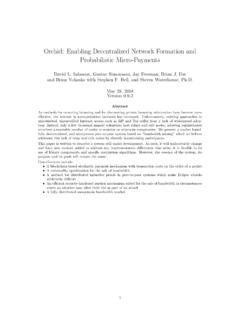Transcription of NEX: A High Performance Decentralized Trade and Payment ...
1 NEX: A High Performance Decentralized Trade andPayment PlatformEthan Fast, PhDNeon ExchangeStanford, CA. bio C. Canesin, MScNeon ExchangeCambridge, MA. Engel, EngNeon ExchangeFlorian polis, Wahle, PhDNeon ExchangeZ rich, SaundersNeon ExchangeMinneapolis, MN. cryptocurrencies are primarily traded on centralized exchanges where userfunds are at risk to hackers and platform managers. Decentralized exchanges(DEXs) allow users to retain control of their funds as trades are mediated by smartcontracts on a blockchain. Unfortunately, today s DEXs are slow, hard to use, andare restricted to trades on a single blockchain. Neon Exchange (NEX) is a newdecentralized exchange that solves these problems, leveraging a high performanceoff-chain matching engine built with Elixir to handle massive order volume, allowcross-chain exchange, and support more complex trading APIs. Many people donot use DEXs because they cannot Trade with their national currencies. NEX is thefirst DEX that will allow its clients to enter the exchange with fiat currencies suchas USD, powered by a global network of licensed third services are critical not just for users of cryptocurrencies, but also formany other applications built upon blockchain technology.
2 NEX envisions a vibrantecosystem of web-based Decentralized applications (dApps) running across publicblockchains such as NEO, Bitcoin, and Ethereum. These applications requiretools to interact with, make transactions upon, and send data across chains. Toachieve this vision, NEX is developing the first cross-chain browser applications can use this extension to collect payments for goods in anydigital currency, make trades and transactions across blockchains, and interact withsmart contracts across NEO and Ethereum. All of this cross-chain functionality ispowered and made possible by the NEX off-chain matching is issuing 50 million tokens to fund development and future expansion, ofwhich 25 million will be sold to the public. NEX tokens are in the process of beingregistered as a security (first in Europe), and will provide holders with a share ofall revenue generated by the exchange and related services. Revenue per user willbe determined by the number of NEX tokens they hold and the length of time theycommit to staking their tokens.
3 The minimum fee share rate is 25%, increasinglinearly to a maximum of 75% when tokens are staked for two Copyright of Neon Exchange, 20181 IntroductionCryptocurrency markets have grown enormously in recent years, from a daily Trade volume of $60million in January of 2015 to more than $8 billion in November of 2017 [2]. Despite the fact thatmost cryptocurrencies are secured by Decentralized architectures, almost all trades between currenciestake place on centralized exchanges, where funds must be deposited under the control of the entityfacilitating exchange. This layer of centralization puts user funds at risk to hackers and platformmanagers. Most famously, millions of dollars worth of Bitcoin were stolen from Mt. Gox in 2011,and again from Bitfinex in 2016 [29, 21].Recently, Decentralized exchanges have emerged to allow users to Trade without giving up controlof their funds [28,3]. Under these systems, trades are executed by smart contracts on a blockchain,removing the need for a centralized third-party to control user accounts.
4 While these exchangessucceed at their primary goal of decreasing third-party risk, their success comes at the cost of a hugeloss of trading Performance . Smart contracts are far too slow to execute the complex matching logicof order books on high-volume, centralized exchanges. In practice, this means that users cannotexecute complex trades, and presents opportunities for arbitrage on stale orders [11]. Decentralized exchanges also tend to have problems trading cryptocurrencies across chains oragainst national currencies. This is because smart contracts operating on one chain have no meansof reasoning about transactions on another. While mechanisms such as atomic swaps have beenproposed to allow a DEX to Trade assets between independent chains (for example, trading Bitcoinfor Ethereum), none of these mechanisms have achieved widespread use [18]. Today, users who wantto Trade currencies across chains or against national currencies must use centralized centralized exchanges provide speed and flexibility, and Decentralized exchanges provide security,then it is natural to ask: can a hybrid system provide the best of both worlds?
5 In this paper, we proposethat the optimal mix of these properties is provided bya Decentralized exchange with an off-chainmatching engine. Order matching is by far the most computationally expensive operation whenrunning an exchange. By encapsulating this component in an off-chain service, we can reap enormousimprovements in speed, and also support complex trades such as limit or market orders. Similarly, anoff-chain engine can act as a coordinator of transactions across chains, enabling a straightforwardapproach to cross-chain exchange. By committing orders on-chain as they are matched withprovable deterministic behavior we can also retain the security benefits of traditional is a key component and enabler of a broader ecosystem of Decentralized creating the first high Performance API for Decentralized cross-chain exchange, NEX enablesmany new possibilities for and interactions with such applications. For example, if a website takespayment in GAS and a user holds only ETH in their wallet, NEX will allow the user to convert someportion of their holdings and send it to the website, directly from their existing address.
6 Further, thisinteraction can occur seamlessly in a user s browser. The user simply clicks a button on the website:this opens a pre-populated transaction window that will make the necessary conversion then send thetransaction. To support such an ecosystem, we have developed a cross-chain browser extension thatallows websites to communicate with user accounts and the NEX matching Exchange (NEX) is a new Decentralized exchange that embodies these ideas. This white paperpresents our vision for the NEX platform, the Performance benefits of our technical approach, andhow NEX will shape the broader cryptocurrency ecosystem. We also discuss our roadmap over thecoming months and plans for a public token Blockchain and Smart ContractsA blockchain is a Decentralized ledger that can record transactions between two parties in a verifiableand permanent way without the need for a central authority [26]. In 2008, Bitcoin emerged as the firstpublic blockchain with large-scale adoption as a digital currency.
7 Other chains have since attemptedto improve on this technology. Most notably, Ethereum launched in 2015 as the first blockchainwith programmable, Turing complete smart contracts [30]. Smart contracts allow developers topublish programs on a blockchain that anyone can inspect, and that will deterministically executeto accomplish complex goals in a way verifiable to all involved third parties. For example, a smart2contract might accept incoming funds from a user, then release them at a certain date, or collect fundsfrom a series of users and split them evenly. These smart contracts are what make possible moresophisticated distributed on-chain applications such as Decentralized Decentralized ExchangesMany Decentralized exchanges have emerged over the years. In this section, we lay out the Trade -offsin this design space, and how NEX contributes over existing systems. In summary, NEX trades asmall degree of user trust for vastly improved Performance and earliest Decentralized exchanges placed order books directly on the blockchain [5,4].
8 In thesesystems, market makers must perform on-chain transactions every time they want to place, modify, orcancel an order. Further, as new orders are placed, a smart contract must execute matching logic thatruns slowly (and redundantly) on all virtual machines in the network. In general, these exchangestake up a large amount of network bandwidth and operate very slowly, so very few decentralizedexchanges operate under this scheme second class of systems uses automated market maker (AMM) smart contracts, as opposed to anon-chain order book [23,25]. These systems adopt a price adjustment model, where all parties tradewith the AMM, and the spot price of an asset is determined by the resulting market forces. WhileAMMs provide increased availability and Performance over on-chain order books, they are still muchslower than centralized exchanges and must place artificial constraints on supply to prevent theirworking capital from being depleted by potential channels have been proposed to reduce network overhead for the more general problem of assetexchange [22,6], allowing two parties to iterate on a transfer off-chain before ultimately committingto it on-chain.
9 However, state channels are expensive to open and close, usually requiring a securitydeposit and a series of on-chain transactions. For this reason, they are most useful among knownparties who want to manage a series of interactions ( , a bar tab ), not a single party conductingone transaction with a broader from state channels, a more recent class of DEX is based on off-chain relay [28,3]. Inthese systems, market makers broadcast an order off-chain, which can then be picked up by aninterested counter party and passed to a smart contract for fulfillment. These systems require farfewer on-chain transactions to perform a Trade , but still suffer from Performance issues in comparisonto centralized exchanges. Notably, order matching is not automatic in these systems, presentingarbitrage opportunities against users who are slow to cancel their orders. Similarly, the absence ofmatching means that users cannot place more complex orders such as limit buys or market contrast to these approaches, we introduce a new kind of Decentralized exchange, NEX, based ona trusted, off-chain matching engine.
10 This matching engine works exactly like its equivalent in acentralized exchange, but only has control over active orders, and commits trades on-chain withoutaccess to the full balance of a user account. Like exchanges based on off-chain relay, NEX orders arematched off-chain and fulfilled on-chain, but NEX s automatic matching engine reduces opportunitiesfor arbitrage and allows for more complex orders. To ensure trust, NEX provides a public record oforders and a deterministic specification of behavior, so that users can verify orders matched off-chainand claim an award in the event of incorrect behavior. Taken together, this makes NEX the firstdecentralized exchange with Performance comparable to today s centralized Cross-chain ExchangeCross-chain exchange is the process of trading or transferring assets that exist on two differentblockchains (for example, trading NEO for ETH). This kind of exchange is trivial when two partiestrust one another or an independent third party ( , a centralized exchange).








